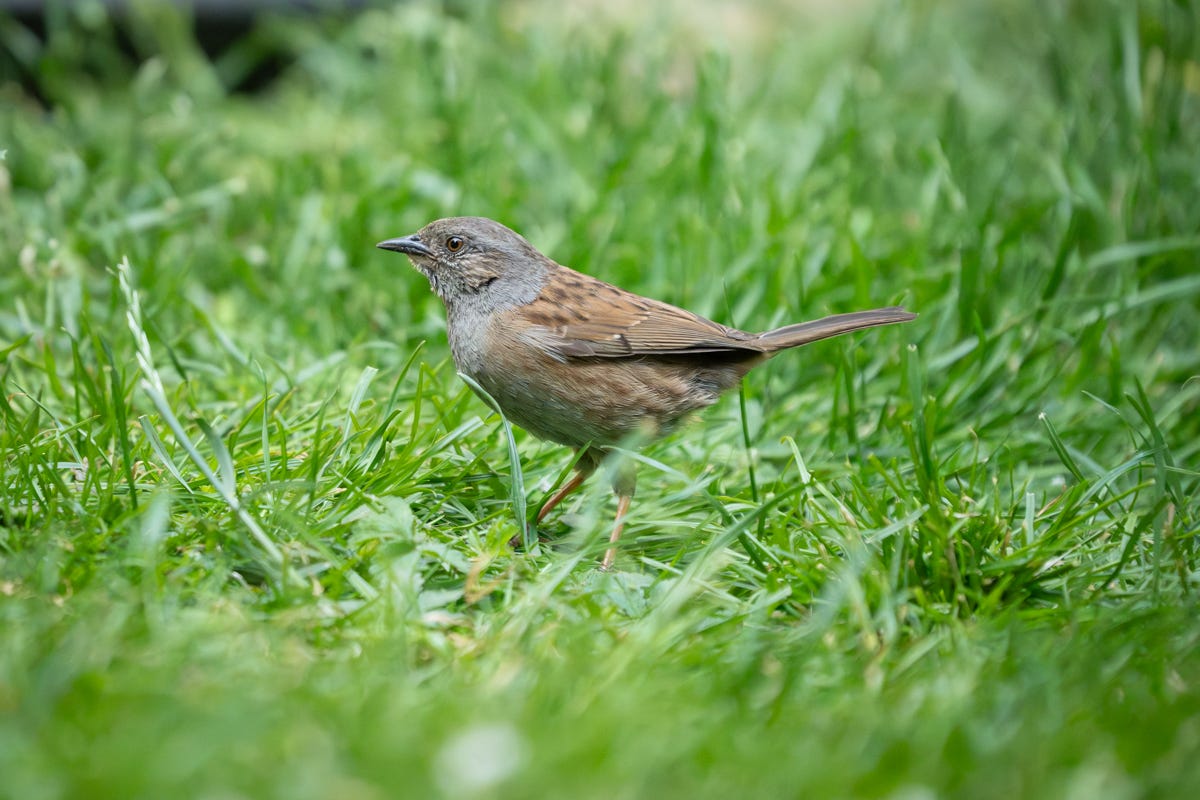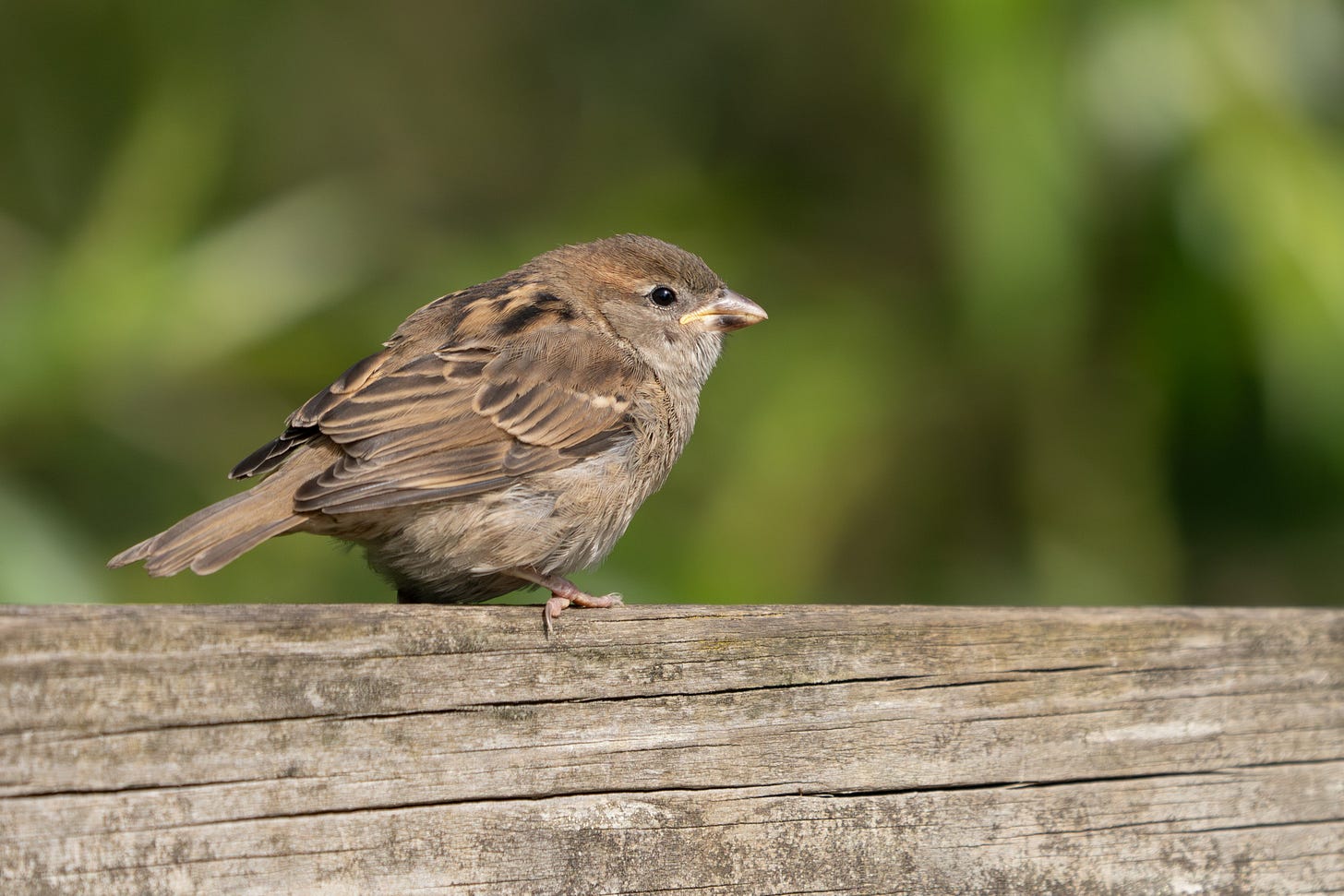Meet the Dunnock
The little brown bird in the hedgerow.
Early morning in the garden, as the grey mist starts to lift and the first rays of sunlight pierce the horizon. As the dawn chorus gets into full swing, one tumbling song stands out from the rest. Emanating from the top of a hedgerow, the high-pitched call pierces the air as it cascades, then stops as suddenly as it begins. A flutter of feathers and the bird disappears into the bush.
Such a loud call, but who made it?!
ID features
There it is – a small, brown bird with a grey tone to its face. Although not striking to look at, the variety of streaked browns on its back and wings are pretty enough. Its dun (greyish) chest gives a clue as to the name of this character: the Dunnock.
Similar in size to a sparrow, but with a more horizontal stance, Dunnocks are propped up on orange or pink legs. They may be small and ‘dull’ looking, but they are brimming with character. From the loud, prominent call, to their dramatic love lives, they don't blend into the background in any way except looks.
Often found alone, or with just one (perhaps two) others, the males and females are identical. The youngsters start out more brown than grey, and when they first emerge from the nest they will have a yellow ‘gape’. This is the bright colouring at the base of the beak, encouraging the parents to feed them. Dunnocks have a dainty, slim beak that is perfect for digging around in little nooks for insects.
Feeding behaviour
Once he’s had enough of singing, he can be found mostly on the ground or in the hedgerows. Here, he hop hop hops, pausing to turn over a leaf and pick off small bugs or spiders. He also snacks on seeds and grains.

Scandal in the shrubbery
So what is it about his behaviour with the female of the species that’s so unusual? Unlike many other garden birds, Dunnocks rarely ‘pair’ up. Both the males and females often have more than one partner.
That means that the males may end up helping several females to raise chicks. But it’s okay if they are spread a little thin – because the females might also have more than one male supporting them!
If you spot a little brown bird on the ground fluttering its wings at another, who then approaches and appears to peck at her rear – they are probably Dunnocks. The male is attempting to remove the previous male’s ‘contribution’ (sperm packet) to increase his own chance of fathering her next clutch of eggs.
Interestingly, female Dunnocks sing to attract their wandering mates back to their territory, sometimes getting into singing duels with their male’s other partners.
Where to spot a Dunnock
Despite their larger-than-life antics, these are shy little birds who are usually hidden away in hedgerows. They do, sometimes, feed from hanging bird feeders. But they prefer to forage on the ground beneath them, or visit flat bird tables.
There are several subspecies of Dunnock, which are mostly separated by how dark their plumage is. Western Scotland and Ireland is the darkest subspecies, while our English Dunnock is the palest.
The good news is that these delightful little creatures can be found across the whole of the UK (except the very highest, mountainous areas) all year round. Shy they may be, but rare they are not.
Easily confused with…
Dunnocks often get mistaken for House Sparrows, especially females and juveniles (shown below). Also brown, and (of course) sparrow sized! But these birds have no grey on them – they are a beige colour underneath, brown on top and have a much chunkier beak. They usually carry themselves more ‘upright’ or vertically than Dunnocks (but this is a side note, not a reliable means of identification).
Juvenile Robins are also small and brown all over. They are paler on the underside than Dunnocks, with no streaking on their back and slightly longer legs. And fortunately, they develop their characteristic red breast after just a few weeks, which makes identification a lot easier!
The Wren has no grey on it and has horizontal ‘bars’ in its plumage rather than streaks running down their back. They often have a pale ‘eye stripe’ that the Dunnock does not. Wrens are much smaller than Dunnocks and have a very (very!) short tail that usually sticks up at an angle.
Bonus Dunnock facts
Dunnocks used to be called ‘Hedge Sparrows’, but they aren’t actually related to sparrows, so this is not accurate.
‘Dunnock’ comes from the Olde English words ‘Dun’ (brown) and ‘Ock’ (small) – it’s the original ‘small brown bird’!
Their Latin name is Prunella modularis, which (very roughly) comes from the German word for Dunnock (which also means brown) and the Latin word for singing.
The blue-green eggs of Dunnocks were thought to repel witches and spirits from entering homes through the chimney in folklore.
Dunnock nests are a prime target for Cuckoos to lay their eggs in, leaving the smaller species to raise enormous Cuckoo chicks to adulthood.
Dunnocks are in the ‘Accentor’ family, which are usually found in mountainous areas. Only the Dunnock and the Japanese Accentor are found in lowland areas.
If you’d like to hear their lovely, tumbling song, you can listen to it here thanks to the RSPB. And if you’d like to see photos of the fledgling Dunnocks, check out this note and wonderful photos by Linda:
Have you seen a Dunnock this week? And did you know about their chaotic love lives?







Great piece celebrating our little brown jobs! I love them. Thank you for the mention 💛 The fledglings are still going strong. They are the cutest!
Beautiful! I didn't know this is what it looks like